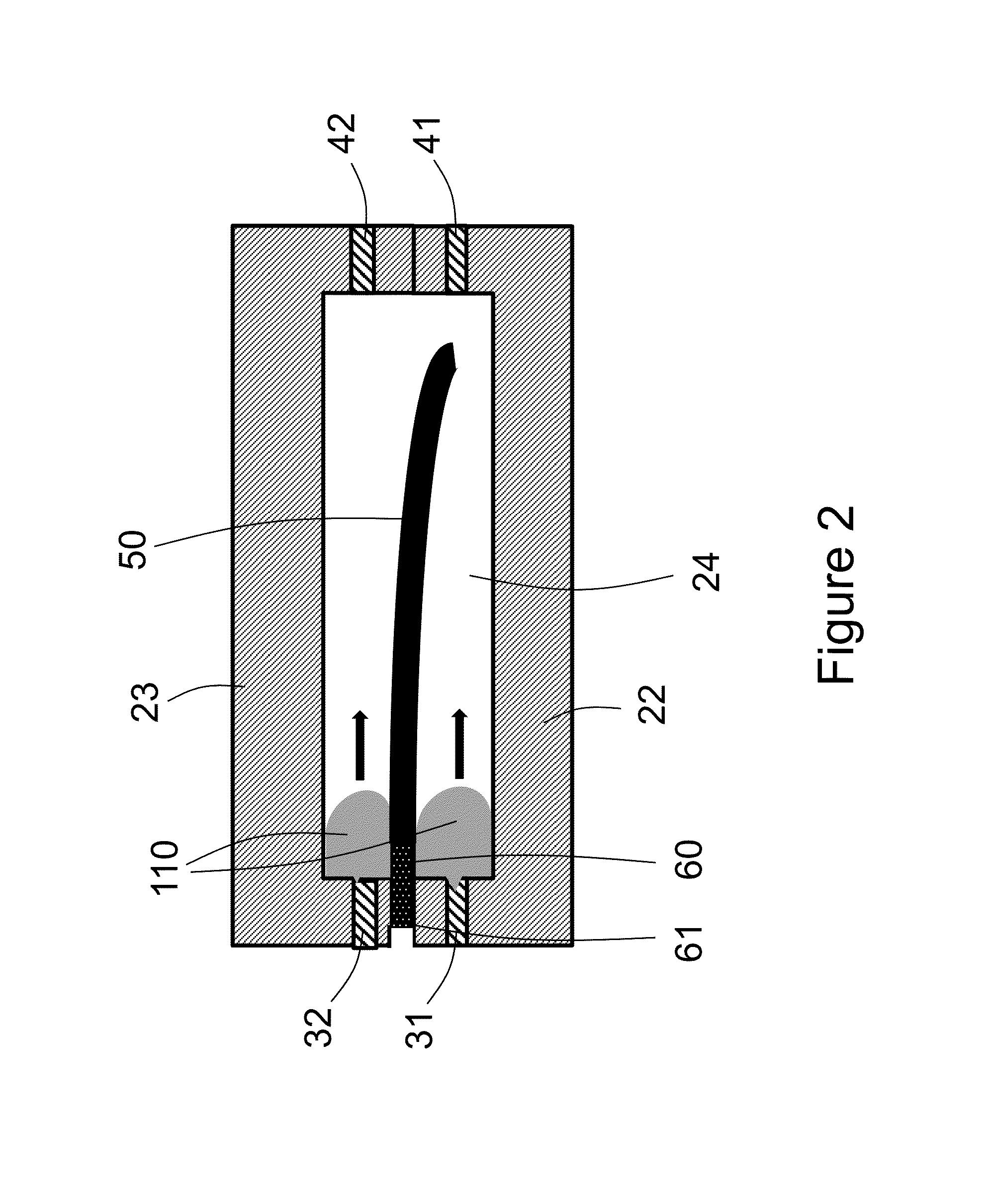Embedded electrooptical display
a technology of electrooptical display and embedded electrodes, which is applied in the direction of optics, instruments, non-linear optics, etc., can solve the problems of physical damage to the display, and achieve the effects of avoiding damage, preserving display flexibility, and fast and inexpensiv
- Summary
- Abstract
- Description
- Claims
- Application Information
AI Technical Summary
Benefits of technology
Problems solved by technology
Method used
Image
Examples
example 1
[0057]A reflective cholesteric liquid crystal display was made by forming a liquid crystal layer by a polymerization induced phase separation (PIPS) technique (U.S. Pat. No. 7,351,506) between two 2 mil PET substrates with conductive polymer layers on a roll-to-roll line. The individual display was placed into a mold, shown in FIG. 1, which was made from two part SortaClear 40 silicone mold material (Smooth-On, Inc.). The mold was filled with optically clear flexible visible light curable material Delo-Dualbond OC VE 512438 (Delo Industrial Adhesives LLC, Sudbury, Mass.) mainly composed of acrylate monomers and oligomers and cured with a Delolux 20 visible light source with peak wavelength 400 nm, 1 min cure time. The mold was designed to prevent flex circuit tab 61 from being covered with light curable material. After forming the optically clear casing (0.5 mm thick) on the front side, the mold was disassembled, the display was turned upside down and placed into a mold like in FIG....
example 2
[0058]A reflective cholesteric liquid crystal display was made by forming the liquid crystal layer by the PIPS technique described in U.S. Pat. No. 7,351,506 between two 2 mil PET substrates with conductive polymer layers on a roll-to-roll line. The 0.5 mm thick shim 103 with a cavity larger than the display area was placed on the bottom substrate 102 as schematically shown in FIG. 3. The optically clear flexible visible light curable material 110 (Delo-Dualbond OC VE 512438 material from Delo Industrial Adhesives LLC, Sudbury, Mass.) mainly composed of acrylate monomers and oligomers was dispensed into the cavity formed by 103. The display 50 was placed on top of the light curable material 110. Then the 0.5 mm thick shim 104 with a cavity larger than display area was placed on top of 103 and optically clear flexible visible light curable material 110 (Delo-Dualbond OC VE 512438 from Delo Industrial Adhesives LLC) was dispensed into the cavity formed by 104 (on top of the display). ...
example 3
[0059]The optically clear protective casing in the shape of a protective skin-like case (about 1 mm thick) for a cell phone device or MP3 player was formed on the top of the reflective cholesteric liquid crystal displays in which the liquid crystal material made by a PIPS technique is disposed between two 2 mil PET substrates with conductive polymer layers on a roll-to-roll line. The individual display was placed into a mold made from two part SortaClear 40 silicone mold material (Smooth-On, Inc.) having a cavity in the shape of a protective case for a cell phone or MP3 player. The mold was filled with optically clear flexible visible light curable material Delo-Dualbond OC VE 512438 (Delo Industrial Adhesives LLC, Sudbury. MA) mainly composed of acrylate monomers and oligomers and cured with a Delolux 20 light source with peak wavelength 400 nm, 1 minute cure time from top and then another 1 minute cure time from the bottom part of the mold. After forming the case the mold was disa...
PUM
| Property | Measurement | Unit |
|---|---|---|
| thick | aaaaa | aaaaa |
| thick | aaaaa | aaaaa |
| peak wavelength | aaaaa | aaaaa |
Abstract
Description
Claims
Application Information
 Login to View More
Login to View More - R&D
- Intellectual Property
- Life Sciences
- Materials
- Tech Scout
- Unparalleled Data Quality
- Higher Quality Content
- 60% Fewer Hallucinations
Browse by: Latest US Patents, China's latest patents, Technical Efficacy Thesaurus, Application Domain, Technology Topic, Popular Technical Reports.
© 2025 PatSnap. All rights reserved.Legal|Privacy policy|Modern Slavery Act Transparency Statement|Sitemap|About US| Contact US: help@patsnap.com



